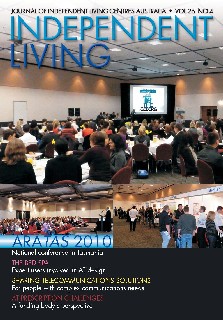
Publications
Independent LivingVolume 26 No 4
published in December 2010
Featured Articles
ARATAS 2010 Conference
- A look at ARATA's national conference held in TasmaniaBy Karen Frost & Chris Bryg, ILC Tasmania
'AT: The tip of the iceberg' was about acknowledging that the technology we use is just a small part of the bigger picture of assistive technology. Many factors infl uence the success of technology – to keep it afloat. Many of these factors are the things we don’t see; the elements that lie beneath the surface or operate in the background.
ARATAS 2010 was an opportunity to highlight systems that ensure success. It was also an opportunity to discuss what doesn’t work – things which could make 'the iceberg' sink!
The Bed Spa
- Expert Users Involved in AT DesignBy Ricky Buchanan & Natasha Layton
Ricky is a university educated blogger and advocate, who has lived with the effects of chronic illness for much of her adult life.
At the time of this paper, it had been 10 years since Ricky had been able to have a shower, as, apart from transferring onto a bedside commode, she lies supine in bed. This paper tells the story of Ricky’s search for a way to bathe in bed. This journey challenged the capacity of one State funding body to both support the user expert and to provide an individualised solution. Obtaining this optimal bathing solution illustrates the complexity of getting needed AT solutions for individuals living with disabilities.
Sharing Telecommunications
- For people with complex communication needsBy Rob Garrett, Toan Nguyen & Harriet Korner
Communications are taken for granted by many people, but for people who have complex communication needs, everyday communication requires significant effort. Telecommunications have often been in the “too hard” basket, thereby acting as a severe restriction to people’s lives.
Over the past decade, people working in the field of disabilities in Australia have played a significant role in pushing for support for people with disabilities to access mobile phone technology. As a result of many years of meetings and negotiations between government and telecommunications stakeholders, the Australian “C625:2009 Information on Accessibility Features for Telephone Equipment”. Industry Code was written and now requires home & mobile phone importers to list features of significance to those with a disability. Subsequently the work done on mobile phones was used as the basis of an international online database that was launched in 2009.
AT Prescription Challenges
- A Funding Body's PerspectiveBy Jackie Hillier & Linda Elliott, Statewide Equipment Advisors, Enable NSW
EnableNSW funds a significant proportion of assistive technology (AT) for people with disabilities in NSW, primarily in the areas of self care, mobility, communication and respiratory support to promote independence at home and participation in the community.
Regardless of the funding source it is vital that AT meets the consumer’s need, is safe and fi t for use and is cost effective.
Sound assessment and prescription is a key component in producing positive AT outcomes.
AT... Easy as ABC
- Assistive Technology, Early Intervention, Augmentative & Alternative CommunicationBy Nichola Midgley, Michael Berryman, Samantha Frain, Northcott Disability Services, NSW
From July 2007-June 2009, Northcott Computer Assistive Technology Services (CATS) implemented a new collaborative model of service for children aged 0-6years that focused on the EI Centre as the hub of training, support and assessments, for clients. The new model used screening assessments, comprehensive training and a short-term loan pool.
Clients received an assessment and support staff at EI Centres had the opportunity to learn about the implementation of recommended technology, and ready-to-use strategies. The feedback from the project was overwhelmingly positive and has changed the way that Northcott CATS provides its services.
